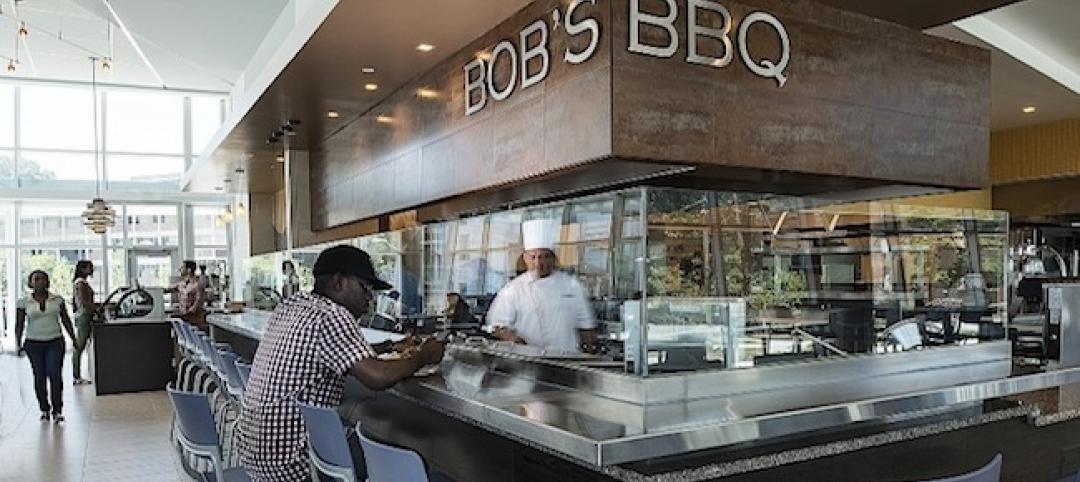Maclay School, a Tallahassee-based college preparatory school, has unveiled three new student labs made from refurbished shipping containers. The three labs, combined with a shared courtyard and gardens designed to foster collaboration, are collectively known as the Beck Family Research Center (BFRC).
Each lab will house a different focus: Biomedical and Student Research; Art, Inspiration, and Design; and Computer Science, Robotics, and Engineering. The containers were constructed off-site and shipped to the school. The labs include similar resources to those offered by research universities such as technology, active learning furnishings, and hands-on equipment. The furniture in all three labs is flexible and mobile to help create student-centered instruction and easy collaboration.

See Also: ASU Health Futures Center combines a novel design and approach to learning
An outdoor garden features raised beds that can double as seating. The beds contain plants that were selected for their potential to be used in lesson plans across all grade levels. The garden also includes a Solar SmartFlower. The SmartFlower uses solar panels arranged like flower petals to track the sun’s position throughout the day. When bad weather rolls in or the sun goes down, the “petals” retract, opening again when the sun comes out. The SmartFlower provides data for students to monitor and study on campus as part of the curricululm.



Related Stories
| May 20, 2014
Kinetic Architecture: New book explores innovations in active façades
The book, co-authored by Arup's Russell Fortmeyer, illustrates the various ways architects, consultants, and engineers approach energy and comfort by manipulating air, water, and light through the layers of passive and active building envelope systems.
| May 19, 2014
What can architects learn from nature’s 3.8 billion years of experience?
In a new report, HOK and Biomimicry 3.8 partnered to study how lessons from the temperate broadleaf forest biome, which houses many of the world’s largest population centers, can inform the design of the built environment.
| May 15, 2014
'Virtually indestructible': Utah architect applies thin-shell dome concept for safer schools
At $94 a square foot and "virtually indestructible," some school districts in Utah are opting to build concrete dome schools in lieu of traditional structures.
| May 13, 2014
Steven Holl's sculptural Institute for Contemporary Art set to break ground at VCU
The facility will have two entrances—one facing the city of Richmond, Va., the other toward VCU's campus—to serve as a connection between "town and gown."
| May 13, 2014
Universities embrace creative finance strategies
After Moody’s and other credit ratings agencies tightened their standards a few years ago, universities had to become much more disciplined about their financing mechanisms.
| May 13, 2014
19 industry groups team to promote resilient planning and building materials
The industry associations, with more than 700,000 members generating almost $1 trillion in GDP, have issued a joint statement on resilience, pushing design and building solutions for disaster mitigation.
| May 11, 2014
Final call for entries: 2014 Giants 300 survey
BD+C's 2014 Giants 300 survey forms are due Wednesday, May 21. Survey results will be published in our July 2014 issue. The annual Giants 300 Report ranks the top AEC firms in commercial construction, by revenue.
| May 10, 2014
How your firm can gain an edge on university projects
Top administrators from five major universities describe how they are optimizing value on capital expenditures, financing, and design trends—and how their AEC partners can better serve them and other academic clients.
| May 9, 2014
5 trends transforming higher education
Performance-based funding models and the adoption of advanced technologies like augmented reality for teaching are just a few of the predictions offered by CannonDesign's higher education sector leader, Brad Lukanic.
| May 5, 2014
8 modern trends in student dining
Creating a dining experience for the modern millennial requires not only a deep knowledge of good design, but also an understanding of what makes today’s students tick. Culinary designers and consultants provide insights into what trends are transforming the campus table.

















